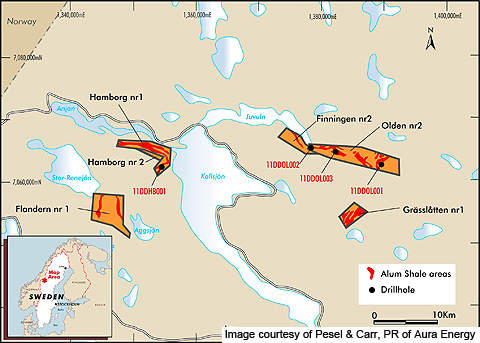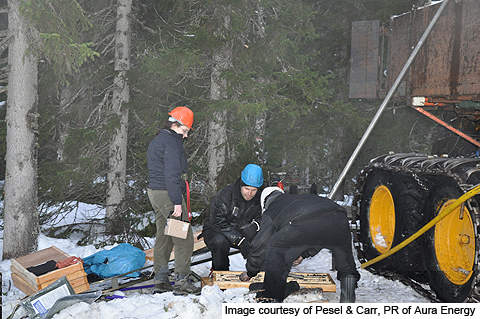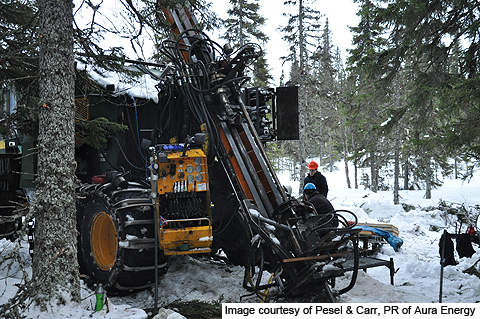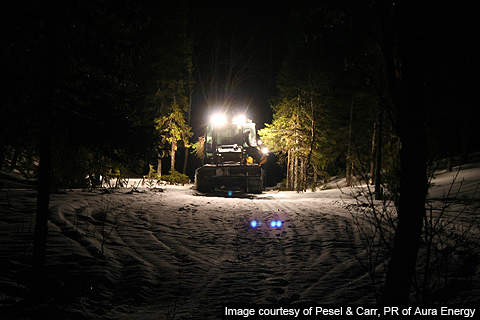The Kallsedet uranium project is located near Kallsedet in Sweden, close to the Norwegian border. The mine was discovered in the 1970s by the Swedish Government, which identified good grades of uranium during the initial days of exploration.
The project is owned by Aura Energy, an Australia-based uranium explorer that owns advanced-stage projects in Sweden, West Africa and Australia. Aura Energy acquired 90km² of permits for the project in October 2009. The company aims to develop a pipeline of uranium projects in Sweden. The Kallsedet uranium project has been identified as the second major uranium project in Sweden.
Aura Energy’s primary uranium project under development is the Haggan project, which is located approximately 120km south-east of Kallsedet. With 291 million pounds of triuranium octoxide (U3O8) resources, the Haggan project is one of the ten largest uranium deposits in the world.
The Kallsedet project is currently in the exploration stage of development. The deposit covers 147km² and is underlain by a significant layer of alum shale. A drilling programme to explore the potential of the exposed alum shale in the permits was completed in May 2011. Results confirmed the presence of significant amounts of uraniferous shale in the Kallsedet area. As evaluation of the drilling results is underway, the company is yet to make any reserve estimates. It is also not yet known when the mine will begin production and what the method of mining will be. The company will however apply the same technology that will be used for its Haggan project to process alum shale.
To explore the potential of the outcropping alum shale and alum shale at depths, Aura Energy plans to carry out additional drilling in 2011 in the permit zones held by the company.
Kallsedet geology
The deposit is characterised by stratigraphy of the Proterozoic and Paleozoic ages, including large volumes of uranium-rich alum shale. Alum shales are known to host the largest depositories of uranium in the world. The unit of alum shale found at Kallsedet is geologically identical to that found at the Haggan project.
The Cambrian aged alum shale at Kallsedet ranges in thickness across the deposit area. It is a fine-grained, carbon-rich, black shale unit, with no calcite veining, which favours easy metal extraction. The unit was concentrated in a marine environment during a prolonged period of geological stability. It lies over shallow marine quartzites that have been concentrated unconformably over Proterozoic aged crystalline basement. The basement hosts altered granites and porphyries.
The alum shale at Kallsedet is believed to have been intercalated with shales, limestones and quartzites of low metamorphic grade. Where the unit does not outcrop, it is overlain by quartzites of variable thickness.
Drilling
Drilling at Kallsedet began in January 2011. The programme included four holes extending 419m in three permits – Olden, Hamburg and Grasslotten. At the Olden permit, three holes were drilled.
One hole was drilled at the Hamburg permit. The programme confirmed extensive uranium mineralisation.
The mineralisation was found to be thicker than what was indicated in the surface mapping, with shale intersections ranging between 12m and 90m in total thickness. Results included one hole that intersected 66m at 144 parts per million (ppm) uranium and 60m at 144ppm uranium including 6m at 224ppm U3O8.
During the earlier fieldworks at Kallsedet, several radiometrically anomalous zones were identified corresponding to the position of alum shale. Several samples of shale reported high grades of uranium. One sample collected by the Swedish Geological Survey returned 304ppm U3O8. A sample collected by Aura Energy reported 233 ppm U3O8. Besides this, 19 samples of 81 had more than 100ppm U3O8 despite surface leaching.







